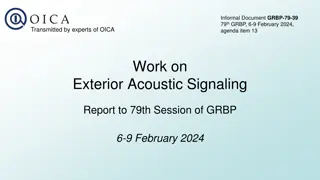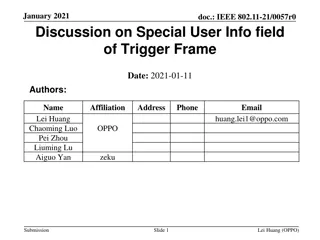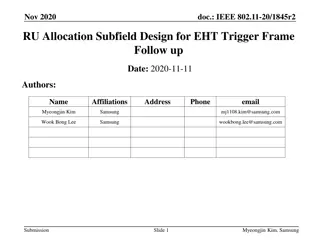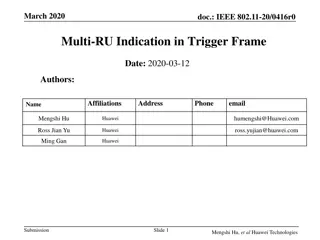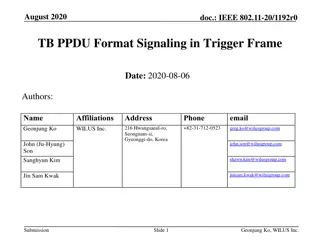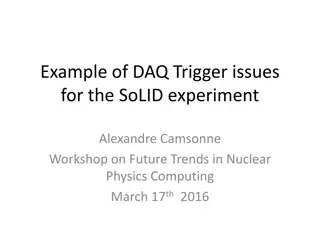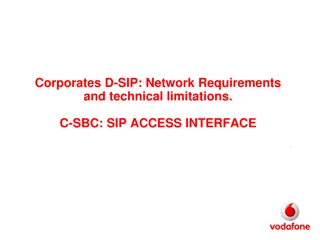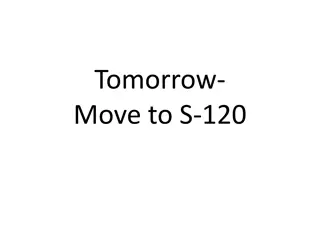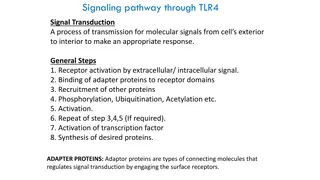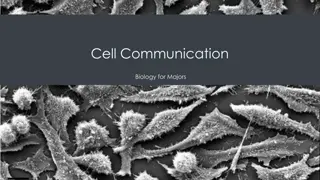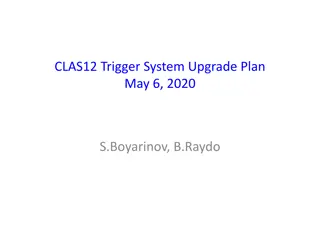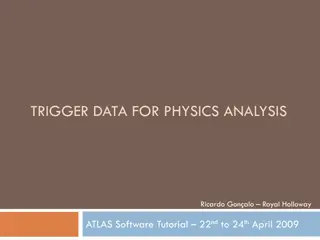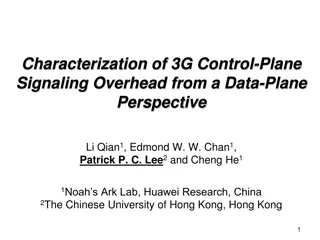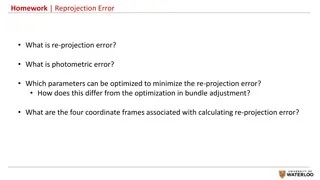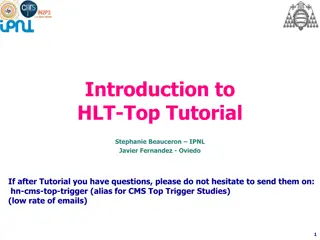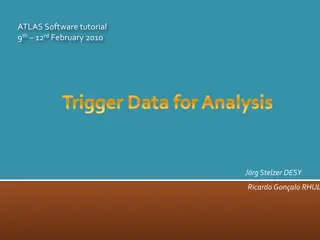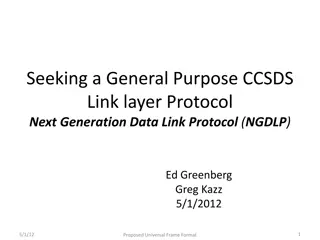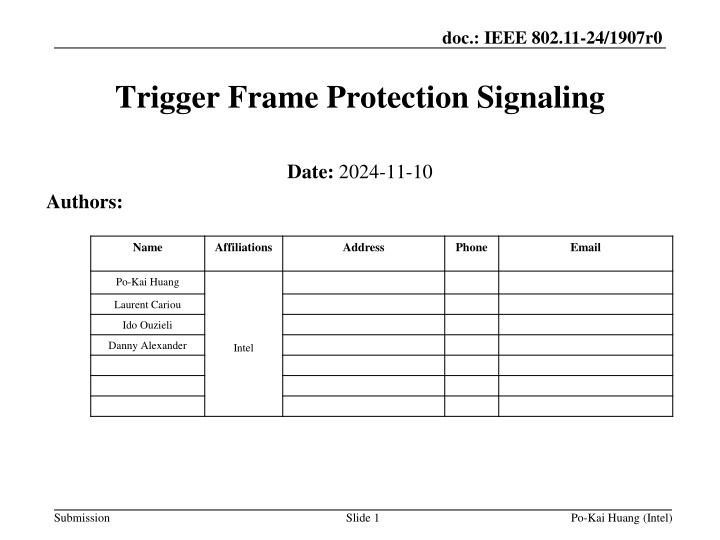
IEEE 802.11-24/1907r0 Trigger Frame Protection Signaling Details
Explore the details of trigger frame protection in IEEE 802.11-24/1907r0 presentation, covering key elements like Key ID field, PN field, MIC field, and more for authentication and security measures in wireless communication standards.
Download Presentation

Please find below an Image/Link to download the presentation.
The content on the website is provided AS IS for your information and personal use only. It may not be sold, licensed, or shared on other websites without obtaining consent from the author. If you encounter any issues during the download, it is possible that the publisher has removed the file from their server.
You are allowed to download the files provided on this website for personal or commercial use, subject to the condition that they are used lawfully. All files are the property of their respective owners.
The content on the website is provided AS IS for your information and personal use only. It may not be sold, licensed, or shared on other websites without obtaining consent from the author.
E N D
Presentation Transcript
doc.: IEEE 802.11-24/1907r0 Trigger Frame Protection Signaling Date: 2024-11-10 Authors: Name Affiliations Address Phone Email Po-Kai Huang Laurent Cariou Ido Ouzieli Danny Alexander Intel Submission Slide 1 Po-Kai Huang (Intel)
doc.: IEEE 802.11-24/1907r0 Abstract Trigger frame protection has been discussed in various presentations Key ID field, PN field, and MIC field are required to enable authentication of the Trigger frame Padding field may be required to provide enough time for MIC computation In this presentation, we provide further details for the design consideration above. Submission Slide 2 Po-Kai Huang (Intel)
doc.: IEEE 802.11-24/1907r0 Location of Key ID field Key ID field, likely one bit, is required for the receiver to retrieve the key Retrieve the key early can enable early computation of MIC while doing reception and potentially reduce the required padding Proposal: have the Key ID bit in the common info field of the UHR-variant Trigger frame The earliest location to have the bit To enable Trigger frame protection while UHR is aggregated with legacy HE/EHT STA in HE/EHT-variant Trigger frame, the same proposal can apply to HE/EHT-variant Trigger frame Submission Slide 3 Po-Kai Huang (Intel)
doc.: IEEE 802.11-24/1907r0 Location of MIC and PN field We need to insert MIC and PN in the Trigger frame in the legacy compatible fashion This is the same design consideration for IFCS Expect that MIC and PN fields are in front of the IFCS if both are present in a Trigger frame Proposal: using similar ways to include MIC/PN fields and IFCS fields. Submission Slide 4 Po-Kai Huang (Intel)
doc.: IEEE 802.11-24/1907r0 Indication whether Trigger frame is protected When none of the receiving UHR non-AP STA support Trigger frame protection, there is no need to include PN and MIC fields If PN and MIC fields are not included, then Key ID field does not have any meaning. Proposal: Have a bit in Trigger frame to indicate whether Trigger frame is protected or not Bit is reserved if the Trigger frame is not protected Needs to be in the same place of Key ID field. Common Info field is then the natural place UHR non-AP STA that supports Trigger frame protection can skip MIC computation and further parsing if Trigger frame is not protected Submission Slide 5 Po-Kai Huang (Intel)
doc.: IEEE 802.11-24/1907r0 Indication whether BA/BAR is protected From AP s point of view, an indication whether the BA/BAR frame is protected can eliminate the need for key searching if the bit is set to 0 Using only TA field to check if there is a key requires additional time In M-BA, the M-BA maybe sent by AP using group addressed frame, so the same consideration from Trigger frame to have the protection indication applies. Similar consideration with Trigger frame, the bit should be in the same place as Key ID field, and as early as possible. BAR control and BA control are the natural places. Proposal: In a BA/BAR frame that is defined to be protected, one bit is used to indicate that the BA/BAR frame is protected, i.e., with PN and MIC For protected Multi-STA BA, the bit is indicated in BA control field For protected compressed BAR variant and protected Multi-TID BAR variant, the bit is indicated in BAR control field Submission Slide 6 Po-Kai Huang (Intel)
doc.: IEEE 802.11-24/1907r0 Location of Padding bits Fortunately, we already have padding mechanism in Trigger frame. Padding in the Trigger frame can use existing mechanism to provide backward compatibility Padding needs to be after PN and MIC field Similar consideration that padding needs to be after IFCS A summary of different cases is the following With PN/MIC and IFCS PN, MIC, IFCS, padding, FCS With PN/MIC and without IFCS PN, MIC, padding, FCS Without PN/MIC and with IFCS IFCS, padding, FCS Submission Slide 7 Po-Kai Huang (Intel)
doc.: IEEE 802.11-24/1907r0 Conclusion We discuss the Trigger Frame protection format with the following considerations Location of Key ID field Location of PN and MIC fields Indication whether Trigger frame is protected or not Location of Padding bits On the similar not of indicating Trigger frame is protected or not, have similar indication for BA/BAR that are defined to be protected in BA control and BAR control Submission Slide 8 Po-Kai Huang (Intel)
doc.: IEEE 802.11-24/1907r0 Straw Poll: Do you agree with the following: for UHR-variant trigger frame TF protected or not: 1 bit field in UHR-variant common info field TBD for HE/EHT-variant in a BA/BAR frame that is defined to be protected, one bit is used to indicate that the BA/BAR frame is protected, i.e., with PN and MIC? For protected Multi-STA BA, the bit is indicated in BA control field For protected compressed BAR variant and protected Multi-TID BAR variant, the bit is indicated in BAR control field Submission Slide 9 Po-Kai Huang (Intel)
doc.: IEEE 802.11-24/1907r0 Reference [1] 11-23-286 Trigger frame protection [2] 11-23-0312 Thoughts on Secure Control frames [3] 11-23-1914 Enhanced Security Considerations in UHR [4] 11-23-1915 Enhanced Security for Control frame in 11bn [5] 11-23-1933 security enhancement follow up [6] 11-23-2001 Secure Control frames - Follow up [7] 11-24-0151 Establishment of Security Key for Control Frame [8] 11-24-497 security enhancement (control frame protection) follow up [9] 11-24-547 Secure Control frames - Follow Up [10] 11-24-1226 ICF-ICR design Submission Slide 10 Po-Kai Huang (Intel)

